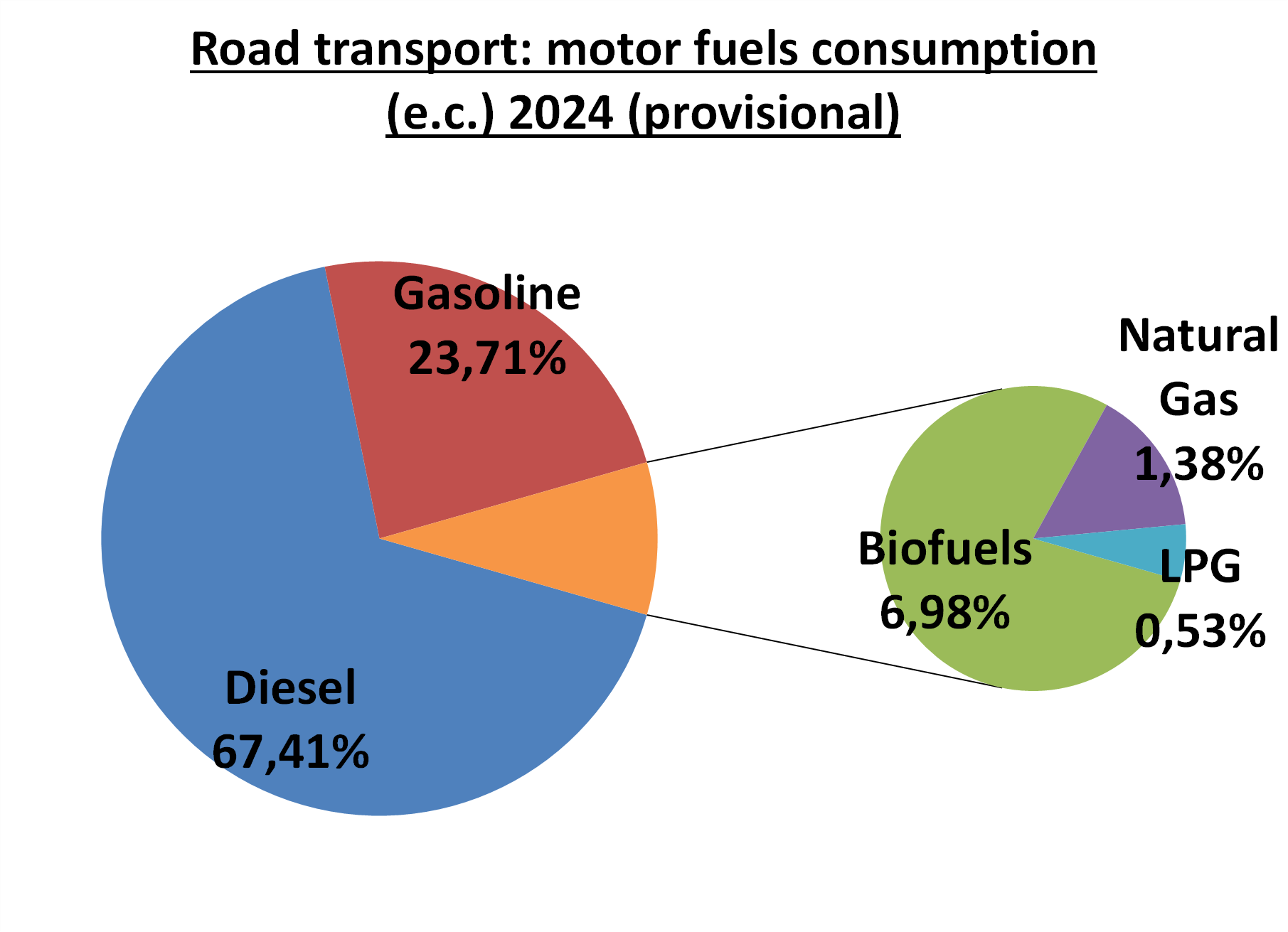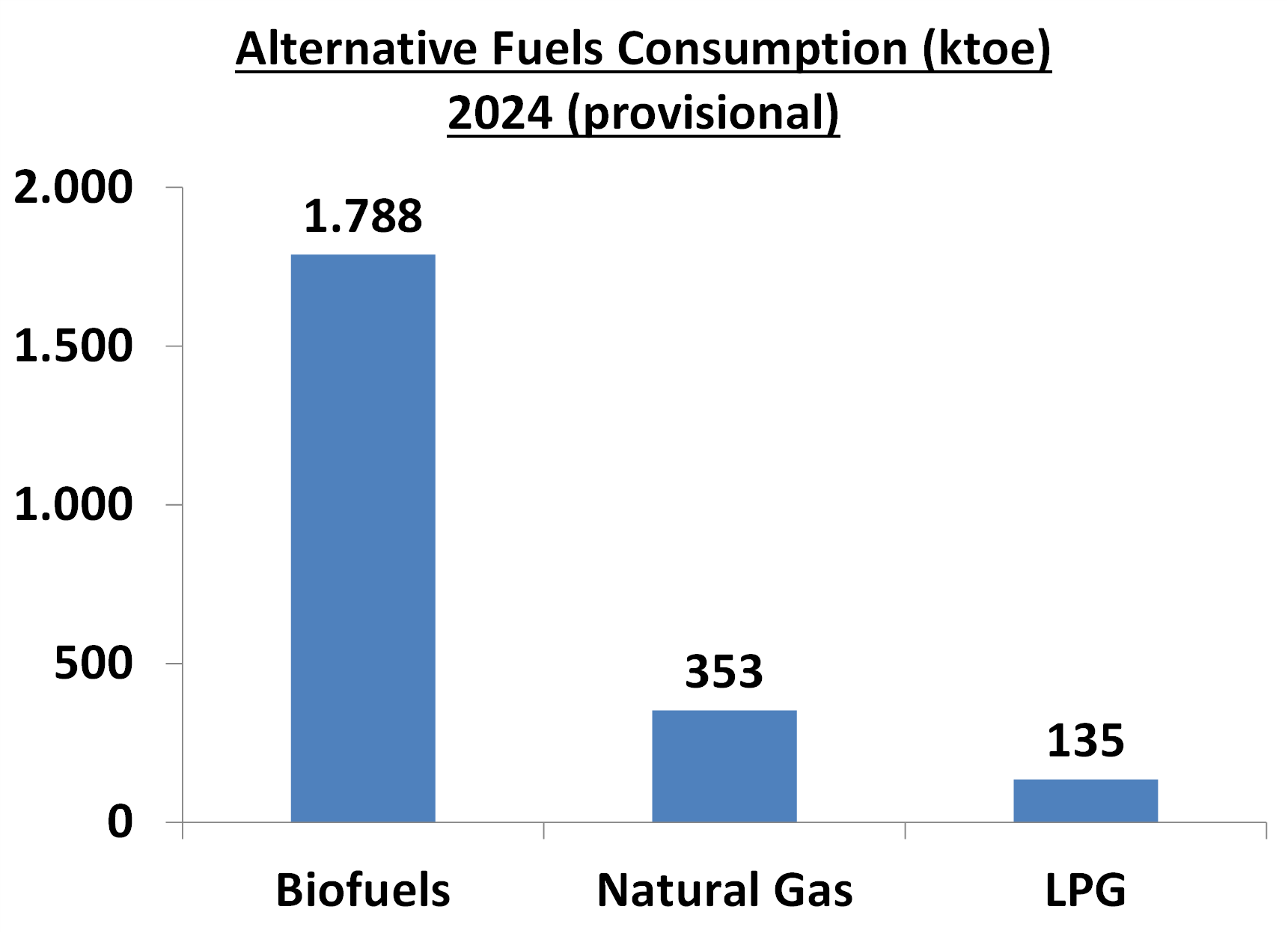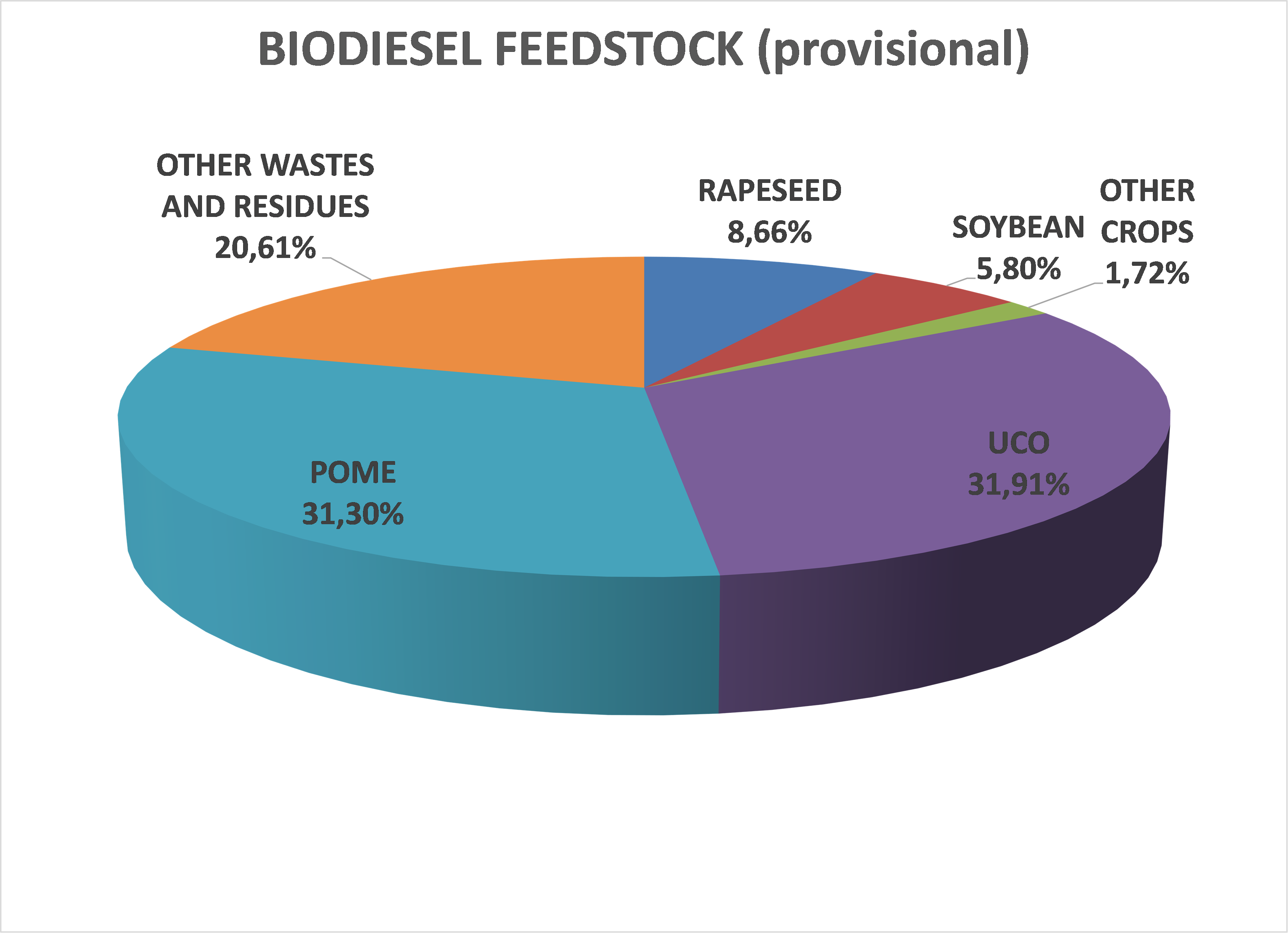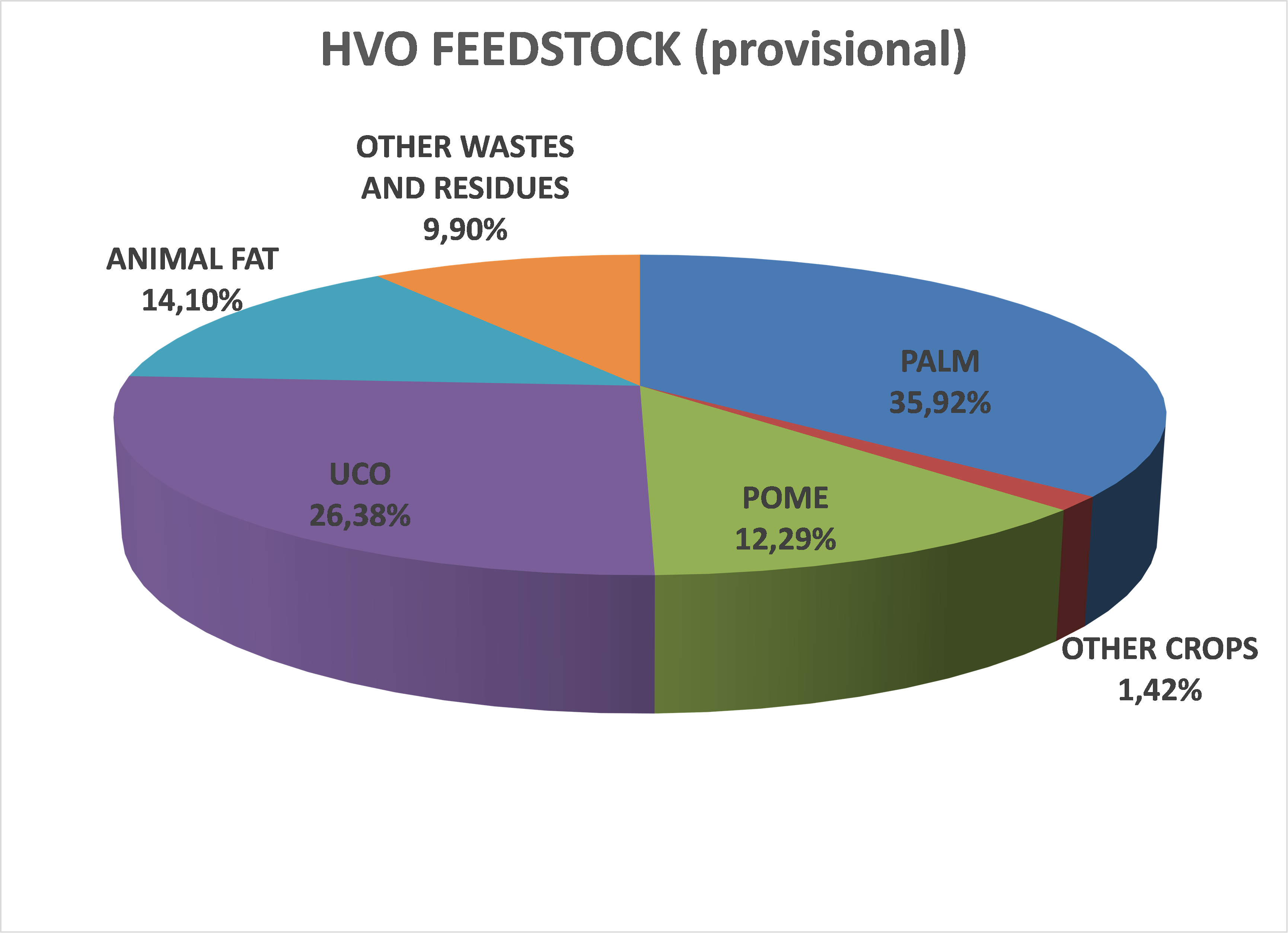Advanced Motor Fuels in Spain
Drivers and Policies
The main policy instrument aimed at fostering the consumption of advanced motor fuels in Spain is the renewable fuels quota obligation, regulated by means of Ministerial Order TED/728/2024. Wholesale and retail fuel operators, as well as consumers not supplied by wholesale or retail operators, are obliged to sell/consume a minimum quota of renewable fuels. Each obligated subject must prove compliance by presenting a number of certificates to a national certification entity, the Ministry for Ecological Transition and Demographic Challenge. Certificates have a value of 1 tonne of oil equivalent (TOE), can be carried over to the following year (up to 30% of the annual obligation), and can be traded. If the biofuel quota obligation is not met, a penalty fee applies (in 2024, the fee was updated to EUR 2,029 per certificate). In case of over-compliance (parties selling or consuming more than they are obliged to), the amounts collected from the penalty fees are redistributed by the certification entity proportionally to the subjects that sold/consumed biofuels at quantities exceeding their quota obligation.
Royal Decree 1085/2015, on the promotion of biofuels, established these mandatory targets for sale or consumption. The 2024 target (in energy content) was 11%. In 2019, the double-counting of some biofuels came into play. Ministerial Order TED/728/2024includes a list of feedstocks that, converted to biofuels, qualify as meeting the biofuels quota obligation. The list also specifies whether a feedstock will be single- or double-counted, as well as information requirements regarding the mandatory sustainability criteria that operators must meet.
Royal Decree 1085/2015 was modified in 2021 to introduce new requirements for obligated parties. For 2024, it established a mandatory target of 0.5% for advanced biofuels (according to the definition included in the Directive [EU] 2018/2001 on promotion of the use of energy from renewable sources). The decree also limited the contribution of biofuels produced from used cooking oil and animal fats (categories 1 and 2) to 1.7%.
Ministerial Order ITC/1342/2022 was issued in 2022 to establish the maximum limit for biofuels produced from food and feed crops. For 2024, this limit was set at 3%.
Also published in 2022 was a call for proposals to allocate 150 million euros from the Recovery, Transformation and Resilience Plan to biogas projects, including plants intended to produce biomethane used for transport.
In 2020, the Spanish Government approved the “Hydrogen Roadmap: a Commitment to Renewable Hydrogen.” The Roadmap is intended to identify the challenges and opportunities associated with full development of renewable hydrogen in Spain. The document provides a series of measures aimed at boosting investment action to take advantage of the European consensus on the role that this energy source should play in the context of green recovery. The Roadmap provides a Vision 2030 and 2050, establishing ambitious country targets in 2030. In particular, regarding transport, the following milestones are projected by 2030:
- A fleet of at least 150 to 200 buses with renewable hydrogen fuel cells.
- At least 5,000 to 7,500 light and heavy hydrogen fuel cell vehicles (FCVs) for the transport of goods.
- A network of at least 100 to 150 hydrogen stations distributed across the country, located no more than 250 km apart.
- Use of hydrogen-powered trains on a continuous basis on at least two commercial medium- and long-distance routes on lines not currently electrified.
- Introduction of handling machinery that uses renewable hydrogen fuel cells and supply points at the top five ports and airports (by volume of goods and passengers).
Advanced Motor Fuels Statistics
Biofuels account for the largest part of alternative transportation fuel in Spain. The largest biofuel contribution is from biodiesel (fatty acid methyl ester [FAME]), the second from hydrotreated vegetable oil (HVO), and the third from bioethanol. Other alternative fuels consumed in Spain are natural gas and liquefied petroleum gas (LPG). Figure 1 shows the share (in terms of energy content) of fuels consumed for road transport and alternative fuels consumption in 2024 (provisional data).


Figure 1. Fuel consumption (share in energy content) in Spain in 2024 (Sources: Ministry for Ecological Transition and Demographic Challenge, Enagás, National Markets and Competition Commission).

Figure 2. Feedstock of biodiesel consumed in Spain in 2024 (Source: Ministry for Ecological Transition and Demographic Challenge).

Figure 3. Feedstock of HVO consumed in Spain in 2024 (Source: Ministry for Ecological Transition and Demographic Challenge).

Figure 4. Feedstock of bioethanol consumed in Spain in 2024 (Source: Ministry for Ecological Transition and Demographic Challenge).
Research and Demonstration Focus
The Spanish Science, Technology and Innovation Strategy is the basic instrument for consolidating and strengthening the nation’s science, technology, and innovation system. The strategy, which will be developed via two state plans (2021–2023 and 2024–2027), prioritises strategic national sectors in specific areas including climate, energy, and mobility. The 2024–2027 State Plan for Scientific and Technical Research and Innovation defines targets and actions for strategic areas identified in the Strategy. It addresses decarbonization and sustainable transport by means of measures intended to foster the development of renewable fuels, as well as more efficient fuels and vehicles.
The National Action Framework for Alternative Energies in Transport supports RDI by means of specific programs related to creation of clusters for innovation, incentives, cooperation through technology platforms, and support to research centers.
The updated integrated National Energy and Climate Plan 2023–2030 (NECP), approved by the Spanish Government in September 2024, addresses general RDI areas, the development of advanced biofuels among them.
Two National Technology Platforms deal with topics related to advanced motor fuels. Bioplat, the Spanish Biomass Technology Platform, brings together companies, research entities, universities, and other organizations in Spain to encourage and promote sustainable commercial development of biomass technology. Bioplat addresses tasks related to biomass resources, production processes, and final uses (including biofuels for transport). The Spanish Hydrogen Technology Platform (PTE-HPC) is aimed primarily at facilitating and accelerating the development and use in Spain of systems based on hydrogen and fuel cells for different applications, transport among them.
Outlook
Directive (EU) 2018/2011, on the promotion of energy from renewable sources, was amended in 2023. The amended version sets a specific renewable fuels target for the transport sector. Member States must establish an obligation for fuel suppliers to ensure that the amount of renewable fuels/renewable electricity supplied to the transport sector results in a final consumption share of at least 29% renewable energy in the transport sector by 2030 or, alternatively, to a GHG intensity reduction of at least 14.5% by 2030. The contribution of biofuels produced from food and feed crops is limited to a maximum of 7%. Within that 29% is a dedicated combined sub-target for advanced biofuels and biogas (which are produced from feedstocks listed in Part A of Annex IX to the directive) and for renewable fuels of non-biological origin (RFNBO). These fuels must be supplied at a minimum of 5.5% of transport energy in 2030, of which a share of at least 1% must be from RFNBO. A specific methodology for the calculation of such shares (including different multipliers for some technologies) is provided in the directive.
EU regulations on ensuring a level playing field for sustainable air transport (ReFuelEU aviation) and on the use of renewable and low-carbon fuels in maritime transport (FuelEU maritime) were approved in 2023. These regulations aim to increase the use of sustainable fuels by aircraft and ships and, consequently, reduce the GHG emissions from these transport sectors. The ReFuelEU aviation regulation will require aircraft fuel suppliers at EU airports to gradually increase the share of sustainable fuels that they distribute to reach 6% in 2030 and 70% in 2050. The FuelEU maritime regulation will require vessels above 5,000 gross tonnage that call at European ports to reduce the GHG emissions intensity of the energy used on board by means of biofuels, biogas, and RFNBO to reach a 6% GHG reduction in 2030 and an 80% reduction in 2050.
According to the updated integrated NECP, in 2030 the share of renewable energy in transport in Spain will be 28% with a GHG emissions reduction of 16.3%, well above the target established in the directive (14.5%). The contribution of biofuels from food and feed crops will be 1.5%, and advanced biofuels and biogas will reach 6.9% while the combined share with RFNBO will be 17.3%.
The main trends included in the NECP for energy consumption in transport over the next decade are as follows:
- A relevant decrease in final energy consumption resulting from increased efficiency and modal shift policies.
- A very significant decrease in the consumption of oil products and natural gas as well as sharp growth in electricity use in vehicles.
The NECP includes specific measures to promote the use of biofuels in transport, the decarbonization of maritime transport, the decarbonization of Spain’s aviation sector, and the development of biogas and biomethane. The measures consist of efforts aimed at supporting biofuels production and consumption, mandatory targets, and aid programs for sustainable aviation fuels facilities, among others.
Additional Information Sources
- Bioplat: Spanish Biomass Technology Platform
- CNMC: National Markets and Competition Commission (in Spanish)
- CORES: Corporación de Reservas Estratégicas (Oil Stockholding Agency) (in Spanish),
- Enagás: Transmission System Operator
- IDAE: Instituto para la Diversificación y Ahorro de la Energía (Institute for Energy Diversification and Saving) (in Spanish)
- Ministry for Ecological Transition and Demographic Challenge (in Spanish)
- PTE-HPC: Spanish Hydrogen Technology Platform (in Spanish)
Major changes
- Publication of the updated National Energy and Climate Plan, which includes shares of renewable energy in transport and GHG emissions reduction to be reached in 2030.
- Publication of the Ministerial Order TED/728/2024, which regulates the obligation of biofuels and other renewable fuels in the transport sector.
Benefits of participation in AMF
Membership in the AMF TCP provides wider and easier access to information on advanced motor fuels, as well as helpful analyses that can be used to guide national policies and programs.


